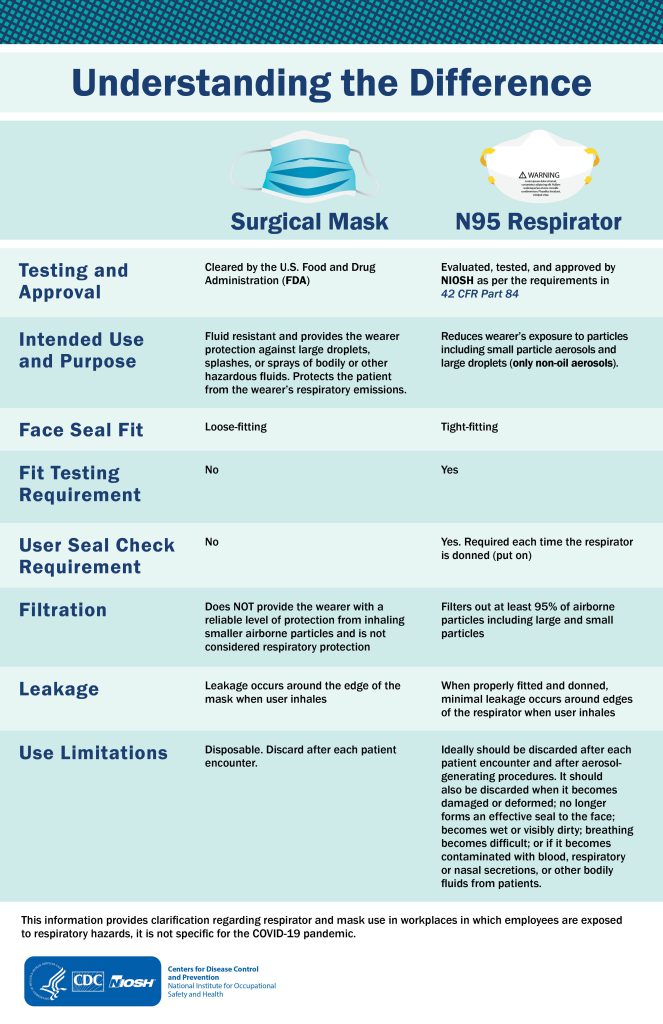Education and Training Concerning Masks and Respirators for Construction Workers
Posted on byVarious types of masks and respirators are receiving increased attention in many workplaces, including on construction sites. Use of masks is part of a multi-layered prevention strategy for COVID-19, and many workplaces require or encourage employees to wear them. Masks are designed to cover a person’s mouth and nose to help contain large droplets or airborne particles when a person exhales, coughs, or sneezes. Respirators provide crucial respiratory protection by filtering out small airborne particles from the user’s inhaled breath. Masks are integral to reducing the risk of COVID-19 transmission while respirators approved by the National Institute for Occupational Safety and Health (NIOSH) protect the wearer from COVID-19 transmission when used properly. When respirators are used in workplaces covered by the Occupational Safety and Health Administration (OSHA), they are required to be used within an OSHA compliant respiratory protection program (RPP) [1].
The COVID-19 pandemic has brought attention to workplace use of masks and respirators and highlighted issues related to respiratory protection guidance across many industries [2-4]. In this blog, we discuss current issues and provide recommendations on education and training concerning the use of masks and respirators in workplaces, with a focus on the construction industry.
Use of Masks and Respirators in the Workplace
A large variety of masks and respirators are being used in workplaces across the country. Examples of different masks and respirators in recent use include cloth masks that do not meet any standard, medical masks (e.g., surgical masks), barrier face coverings, respirators certified to international standards (e.g., KN95s), and NIOSH-approved N95 filtering facepiece respirators (FFRs). Construction workers may also use elastomeric half-mask respirators (EHMRs) or powered air-purifying respirators (PAPRs).
Employers covered by OSHA are required to provide employees with an appropriate respirator, in the context of a RPP, when such equipment is necessary to protect the health of their employees. Only NIOSH-approved respirators meet OSHA requirements. Non-NIOSH-approved respirators such as KN95s cannot be used as respiratory protection in the workplace. This was only temporarily permitted during the COVID-19 pandemic when respirator shortages challenged the nation. Selecting the appropriate respirator is influenced by factors such as level of protection, hazard type, availability, cost, comfort, and fit.
 Employers should inform workers of their potential for work-related inhalation hazards and provide a respirator when required. Additionally, all workers considering using a mask or respirator should be aware of appropriate local public health guidance. Information from employers and local public health guidance are both needed to determine, for example, whether workers should be wearing a respirator at work and/or whether public health guidance includes a recommendation for mask use. It is important for employers and workers to keep up to date on workplace requirements for respirator use and on the types of available and acceptable masks as workplace conditions and COVID-19 policies and guidance change.
Employers should inform workers of their potential for work-related inhalation hazards and provide a respirator when required. Additionally, all workers considering using a mask or respirator should be aware of appropriate local public health guidance. Information from employers and local public health guidance are both needed to determine, for example, whether workers should be wearing a respirator at work and/or whether public health guidance includes a recommendation for mask use. It is important for employers and workers to keep up to date on workplace requirements for respirator use and on the types of available and acceptable masks as workplace conditions and COVID-19 policies and guidance change.
Gaps in Respiratory Protection Guidance
The National Academies of Sciences, Engineering, and Medicine recently published a comprehensive report titled, Frameworks for Protecting Workers and the Public from Inhalation Hazards that is summarized in this NIOSH Science Blog [2,4]. The report highlights that many workers do not necessarily fall under a mandatory RPP and that new or ongoing threats from inhalation hazards will continue to pose challenges for workers. For example, infectious disease experts agree that COVID-19 will not be the last pandemic many of us experience during our lifetime [5,6]. Additionally, existing inhalation hazards and related health effects from emerging hazards continue to present challenges related to the use of respiratory protection (e.g., viruses transmitted through wastewater, smoke from more frequent wildfires, and mold from cleanup and remediation of flood-damaged materials) [7-10].
Using Respirators Voluntarily at Work
OSHA’s respiratory protection standard and standard interpretations (1910.134; 1910.134(c)(2); 1910(c)(4); 1910.134(f); 1910.134(e)) allow workers to wear respirators on a voluntary basis when respiratory protection is not required to meet any OSHA standard [11]. This includes workers who may want to protect themselves from an airborne hazard that does not exceed OSHA’s exposure limits or to increase their comfort in a non-hazardous situation (e.g., dust exposure while sweeping). If an employer provides respirators for voluntary use, or if a worker provides their own respirator, certain precautions should be taken to be sure that the respirator itself does not present a hazard. Under voluntary use:
- Employers are not required to implement a written RPP when only FFRs are used. However, employers must ensure the respirator does not present a health hazard to the worker.
- Employers are not required to pay for FFRs used voluntarily by employees.
- Voluntary respirator use does not require fit testing in work atmospheres that are not hazardous.
- Facial hair is not prohibited under voluntary respirator use but is discouraged because facial hair is likely to compromise the seal of the respirator.
- If respirators other than FFRs are used (e.g., EHMRs), employers must implement some elements of an RPP to ensure that the worker is medically fit to wear a respirator and that the respirator is correctly cleaned, stored, and maintained.
Training on the Principles of Respiratory Protection
Workers without an RPP likely have had minimal training on respiratory protection and will likely remain unfamiliar with the topic–even after the COVID-19 pandemic [12]. There are a variety of resources available (below) that can be used to gain a better understanding of the fundamentals of respiratory protection, including advantages and limitations associated with different types of respirators.
- Respiratory Protection vs. Source control – What’s the difference?
- Who Does What? The Roles of NIOSH, OSHA, and the FDA in Respiratory Protection in the Workplace
- Types of Respiratory Protection
- A Guide to Air-Purifying Respirators
- Filtering Out Confusion: Frequently Asked Questions about Respiratory Protection
- The Need for Fit Testing During Emerging Infectious Disease Outbreaks
Workers should also understand proper donning (putting on) practices -including a user seal check- doffing (taking off) practices, use, care, and maintenance [13].
Respiratory Protection in the Construction Industry
In construction, RPPs may already exist for worksites with workers encountering specific respiratory exposures, such as silica or wood dust. In those situations, there is already some familiarity with requirements of respirator use (e.g., fit testing) and capacity for building on workers’ existing knowledge, education, and training.
Training should be expanded or adapted as needed, to include different respirator types (e.g., EHMRs, PAPRs) and different segments of the worker population. However, for employers that do not have an RPP and do not feel comfortable or fully qualified to provide this training to their workers regarding protection against potential respiratory hazards, there are several free, science- and evidence-based training resources online.
- OSHA Respiratory Protection in Construction
- The Center for Construction Research and Training (CPWR) Webinar: NIOSH Activities Supporting the Optimization of Respiratory Protection
- NIOSH NPPTL Respiratory Protection Videos (General)
- University of Nebraska Medical Center HEROES PPE Training Videos (General)

Additionally, in the construction industry, resources like NIOSH’s Respiratory Protection Toolbox Talk, are available to explain respiratory protection to construction workers.
Now that more workers have had an “introduction” to the masks and respirators used during the COVID-19 pandemic, it is time to step back and make sure all workers know relevant and up-to-date information about the variety of masks and respirators available to them, and the fundamentals of respiratory protection. This information is a starting point for protecting workers from current and emerging workplace inhalation hazards.
Below are additional sources on respiratory protection that may be helpful.
- The National Academies of Sciences, Engineering, and Medicine – Recommendations to Meet the Respiratory Protection Needs of Workers without Respiratory Protection Programs
- The National Academies of Sciences, Engineering, and Medicine – Consensus Study Report Highlights
- American Industrial Hygiene Association- The Synergist “Respiratory Protection Training for Non-Experts”
- NIOSH – Respirator Selection Guide for the Construction Industry
Aurora Le, PhD, MPH, CSP, CPH, is the John G. Searle Assistant Professor of Environmental Health Sciences at the University of Michigan School of Public Health.
Douglas Trout, MD, MHS, is Deputy Director for the NIOSH Office of Construction Safety and Health.
Meghan Kiederer, BA, is a Health Communications Intern for the NIOSH Personal Protective Technology Laboratory.
Adam K. Smith, PhD, is a Senior Scientist for the NIOSH National Personal Protective Technology Laboratory.
Scott Earnest, PhD, PE, CSP, is the Associate Director for the NIOSH Office of Construction Safety and Health.
References
- Occupational Safety and Health Administration. 1910.134- Respiratory protection. 2019. Available from: https://www.osha.gov/laws-regs/regulations/standardnumber/1910/1910.134
- The National Academies of Sciences, Engineering, Medicine. Frameworks for Protecting Workers and the Public from Inhalation Hazards. Feb 2022. Available from: https://www.nap.edu/catalog/26372/frameworks-for-protecting-workers-and-the-public-from-inhalation-hazards
- Perencevich EN, Diekema DJ, Edmond MB. Moving personal protective equipment into the community: face shields and containment of COVID-19. 2020. JAMA. 323(22):2252-3. http://jamanetwork.com/article.aspx?doi=10.1001/jama.2020.7477
- The National Academies of Sciences, Engineering, Medicine. Consensus Study Report Highlights: Frameworks for Protecting Workers and the Public from Inhalation Hazards. Feb 2022. Available from: https://www.nap.edu/resource/26372/Respiratory_Highlights.pdf
- Marani M, Katul GG, Pan WK, Parolari AJ. Intensity and frequency of extreme novel epidemics. Proceedings of the National Academy of Sciences. 2021. Available from: https://www.pnas.org/doi/pdf/10.1073/pnas.2105482118
- Thomas MB. Epidemics on the move: Climate change and infectious disease. PLoS biology. 2020 Nov 24;18(11):e3001013.
- Mueller W, Horwell CJ, Apsley A, Steinle S, McPherson S, Cherrie JW, Galea KS. The effectiveness of respiratory protection worn by communities to protect from volcanic ash inhalation. Part I: Filtration efficiency tests. International journal of hygiene and environmental health. 2018 Jul 1;221(6):967-76.
- California Department of Industrial Relations. Protecting Outdoor Workers Exposed to Smoke from Wildfires.2021. Available from https://www.dir.ca.gov/dosh/wildfire/Worker-Protection-from-Wildfire-Smoke.html
- Carducci A, Donzelli G, Cioni L, Federigi I, Lombardi R, Verani M. Quantitative microbial risk assessment for workers exposed to bioaerosol in wastewater treatment plants aimed at the choice and setup of safety measures. International journal of environmental research and public health. 2018 Jul;15(7):1490.
- Persaud E, Weinstock D, and Wright DS [2022]. Biosafety and Infectious Disease Occupational Health Training from the NIEHS Worker Training Program: A Historical Look at Capacity Building that Supported a COVID-19 Response. Journal of Emergency Management 20 (7):9-18. https://www.wmpllc.org/ojs/index.php/jem/article/view/3172
- Voluntary use respirators. Available from: https://www.osha.gov/laws-regs/standardinterpretations/2018-04-26
- Manning CR, Paz T. Respiratory Protection Training for Non-Experts: Steps Toward Accessible Respiratory Protection Programs Outside the Industrial Workplace. The Synergist. Available from: https://synergist.aiha.org/202203-respiratory-protection-non-experts
- NIOSH NPPTL. The Respiratory Protection Information Trusted Source. Available from: https://www.cdc.gov/niosh/npptl/topics/respirators/disp_part/respsource.html
Posted on by

